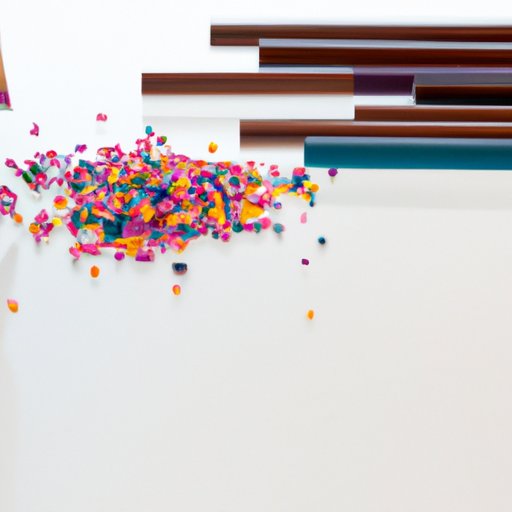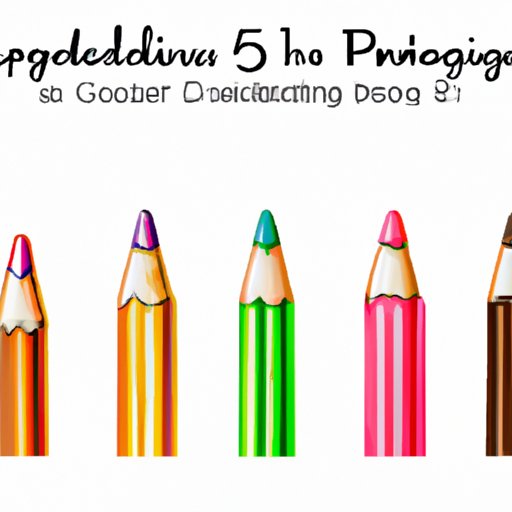
Introduction
When it comes to creating artwork with colored pencils, blending colors is an essential skill for achieving a realistic and polished look. However, for many beginners, blending can be challenging to master, with many different techniques and tools to choose from. In this article, we will explore everything you need to know about blending colored pencils, including tips, techniques, and tools for beginners.
Section 1: Mastering the Art of Blending Colored Pencils: Tips and Techniques for Beginners
To begin, let’s first define the basic blending techniques for beginners, which include layering, burnishing, and using solvents. Layering involves adding multiple layers of color on top of each other to create depth and blending. Burnishing involves applying heavy pressure with a pencil or blending tool to smooth out the pencil strokes and create a shiny, polished look. Using solvents involves applying a liquid such as rubbing alcohol or mineral spirits to dissolve and blend the pigment.
Each technique has its own benefits and drawbacks, depending on the effect you’re trying to achieve. Layering is the most basic and versatile technique, allowing you to create subtle color shifts and build complex blends. Burnishing creates a glossy, polished finish but can also flatten out the paper’s texture. Using solvents can create more vibrant, intense colors, but can also be tricky to apply and requires proper ventilation.
To demonstrate each technique, start by choosing two or three colors that blend well together. Begin by layering the colors on top of each other, using light pressure to create a smooth and gradual transition between each color. Next, try burnishing the colors with a blending tool, slowly building up the pressure until the colors blend seamlessly. Finally, experiment with using solvents, applying a small amount to the paper and blending the colors together with a brush or cotton swab.
Section 2: Creating a Smooth and Polished Look with Colored Pencils: Using the Blending Tool
Blending tools are another essential element for creating a smooth and polished blend with colored pencils. Pencils, tortillons, and blending stumps are common blending tools used by artists.
Pencils are the most straightforward tool to use and are often preferred by beginners. The disadvantage of using a pencil is that it can leave marks on the paper and is not as precise as other tools. Tortillons and blending stumps are paper tools used for rolling and blending color. They are available in different sizes and are perfect for blending small details. The disadvantage of using these tools is that they can hold on the pigment, and it can be challenging to clean.
When using a blending tool, start by applying light pressure and a circular motion over the pencil strokes to blend the colors. Gradually build up pressure with the tool until the colors are entirely smooth and blended. Try using different blending tools to see which one you prefer and to create different blending effects.
Section 3: Maximizing the Potential of Colored Pencils: Experimenting with Different Blending Methods
While the traditional blending techniques mentioned earlier are effective, there are also some less traditional blending methods you can experiment with. Watercolor brushes and blending powders are two examples.
Using a watercolor brush is beneficial for blending colored pencils because it can create a gradient fading effect and has a portable water source. It’s crucial to use a synthetic brush to avoid damaging the bristles. Blending powders are great for creating a soft, subtle blend, but it can be messy and challenging to control.
To use these blending methods, start by applying your colored pencils as you normally would. Next, dip the watercolor brush in water, then lightly stroke it over the pencil strokes. The water will help dissolve the pigment and blend the colors. For blending powders, apply a small amount onto your paper and use a blending tool to blend the pigment together.
Section 4: Blending Colored Pencils: The Importance of Color Theory
Before experimenting with blending techniques, it’s essential to understand the science behind color blending and color theory concepts. There are a few important concepts to grasp when it comes to color theory, including complementary colors, saturation, and hue.
Complementary colors are colors that are opposite each other on the color wheel. When blended together, these colors create a neutral grey. Saturation refers to the intensity of the color, and hue is the specific color’s attribute.
Understanding these concepts can help you create more harmonious and dynamic blends in your artwork. For example, blending a complementary color with a dominant color can create a subtle or dynamic blending effect.

Section 5: From Beginner to Pro: Progressing Your Blending Technique with Colored Pencils
Blending with colored pencils can be challenging at first, but with patience and dedication, you can improve your technique and create professional-looking artworks. To develop your skills, start with basic blending techniques and gradually move on to more advanced techniques as you gain confidence.
Consistent practice and experimentation are the keys to improving your blending technique. Try blending different color combinations and using different blending tools to find what works best for you. Take note of your progress and challenges along the way and keep practicing until you achieve the desired effect.
Section 6: Creating Depth and Dimension in Your Artwork: Tips for Blending Colored Pencils
Finally, it’s essential to understand how to use blending to create depth and dimension in your artwork. Shading is a critical technique for creating the illusion of three-dimensionality in your artwork.
To shade with colored pencils, start by applying light pressure to the area you want to shade, gradually increasing the pressure until it’s darker. Use your blending tool to smooth out the color transition, creating a gradual blend. Repeat this process until you have achieved the desired shading effect.
Combining different blending techniques can also help you create unique and dynamic compositions. For example, layering and burnishing can create a glossy, polished look with subtle shading, while using solvents and blending powders can create a vibrant and intense blend with bold texture.
Conclusion
Blending colored pencils is an essential skill for anyone looking to create realistic and polished artwork. By experimenting with different blending techniques and tools, understanding color theory, and combining different blending methods, you can develop your unique style and achieve professional-looking results.





